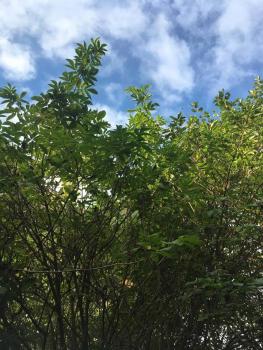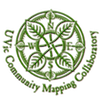Common Names:
Coastal Red Elder, Red Elderberry
First Nations Names:
Upriver Halkomelem: sth’iwuq’ (fruit), sth’iwuq’ulhp (shrub)
Downriver Halkomelem: th’iwuq’ (fruit), th’iwuq’ulhp (shrub)
Island Halkomelem: th’iwuq’ (fruit)
Family: Sambucus
Identification: Red Elderberry (Sambucus rascemosa), is a tall bushy Shrub which can grow to a height of 6 meters. Older plants can have multiple thick trunks covered in rough bark and be surrounded by smaller offshoots. Smaller twigs are often brittle and pithy, while in the spring growing season offshoots are often green and semi-flexible. The leaves of the plant are compound and consist of 5-7 leaflets which are elliptical or lance shaped with small tooth like points running the complete edge of the leaf to the very tip of the lance. During the spring the plant produces white or cream – coloured flowers in roughly pyramid shaped clusters. In summer these flowers give way to bright red fruit which grow in clusters on small purple stems, which easily detach from the plant when the berries become ripe. It is also important to make note of the distinct cat urine smell which the crushed up leaves or young broken stems give off, this scent is a clear indicator of Red Elderberry.
Cautions:
The United States Department of Agriculture cautions against the improper preparation and consumption of this plant. Dr. Nancy Turner former professor of Environmental Studies at the University of Victoria and author of the book Food Plants of Coastal First Nations notes that “Kingsbury (1964) notes that the Bark, wood, leaves, and roots of Red Elderberry are considered to be poisonous, and that eating the uncooked berries may produce nausea. However, there is no definite evidence of the toxicity of elderberries.”[1] Simon Frasier University notes that all parts of the plant contain a poisonous alkaloid and cyanogenic glycoside; however, these occur in low concentrations and the ripe berries are considered edible.
Current Location and Distribution:
Red Elderberry is commonly found throughout Canada and the United States. In the west it is an early to mid seral stage species while in the East it is common to climax stage deciduous forests. While Red Elderberry is shade tolerant it prefers direct sun exposure; it also prefers deep nutrient rich soils that consist primarily of sandy or silty loams. This makes the edges of swamps, marshes, low-laying wet areas, as well as riparian zones the perfect habitat for this species. Red Elderberry routinely occurs at elevations from sea level to sub alpine.
Ethnobotanical Uses:
Despite the fact that governmental organizations and academics alike caution against the consumption of Red Elderberry fruit, while not highly regarded, it remained in the diets of British Columbia First Nations as an important food source. Dr. Nancy Turner in her book Food Plants of Coastal First Peoples states that the Saanich peoples were the only First Nation to regard Red Elderberry as un edible. A good case study for the importance of Red Elderberry as a food source is the Kwak'wala-speaking peoples who would historically gather the ripe berries in late July and August, cook them, dry them and store them in cedar boxes then reconstitute them and eat them during the winter with a mix of other native berries, and often with grease. The berries would often be steamed in pits lined with Skunk cabbage or boiled in cedar boxes. Even today First nations, such as the Bella Coola Nation, still consume the fruit; and with the introduction of refined sugars jams, jellies, and wines are now widely produced and enjoyed. The fruit of Red Elderberry is also very high in vitamins A and C giving it important medicinal qualities. According to Simon Fraser University the berries were also used to treat constipation. Just like the fruit, the wood of the Red Elderberry was also used for numerous different purposes: the shafts were often hollowed of their pithy interior and turned into flutes, whistles or straws making it very important to the culture of many First Nations. View presentation of how to make an Elderberry flute here.
Written by Anthony Auchterlonie.
References
Gonzalves, Pete. 2016. Plant Fact Sheet: Red Elderberry [https://plants.usda.gov/factsheet/pdf/fs_sara2.pdf]. USDA NRCS Plant Materials Center, Corvallis, Oregon. [Accessed 26/11/8:30 PM].
Klinkenberg, Brian. (Editor) 2017. E-Flora BC: Electronic Atlas of the Plants of British Columbia [eflora.bc.ca]. Lab for Advanced Spatial Analysis, Department of Geography, University of British Columbia, Vancouver. [Accessed: 26/11/2017 9:02:41 PM].
Making Elderberry Flutes. (n.d.). Urban Organic [http://urbanorganica.typepad.com/urban_organica/2009/02/making-elderberry flutes.html]. [Accessed 10/11/2017, 2:30 PM].
Red Elderberry: Detailed. (n.d.). [http://www.sfu.ca/halkethnobiology/html/plants/redelderb.htm]. Simon Fraser University, Vancouver. [Accessed 26/11/ 2017, 8:10 PM].
Turner, N. J., 1947, & Royal British Columbia Museum. (1995). Food plants of coastal first peoples. Vancouver: UBC Press.
[1] Nancy J. Turner. 1947, & Royal British Columbia Museum. (1995). Food plants of coastal first peoples. (Vancouver: UBC Press). Pg, 67-68.
Project Status:
Year:
Associated Projects:
Image:

